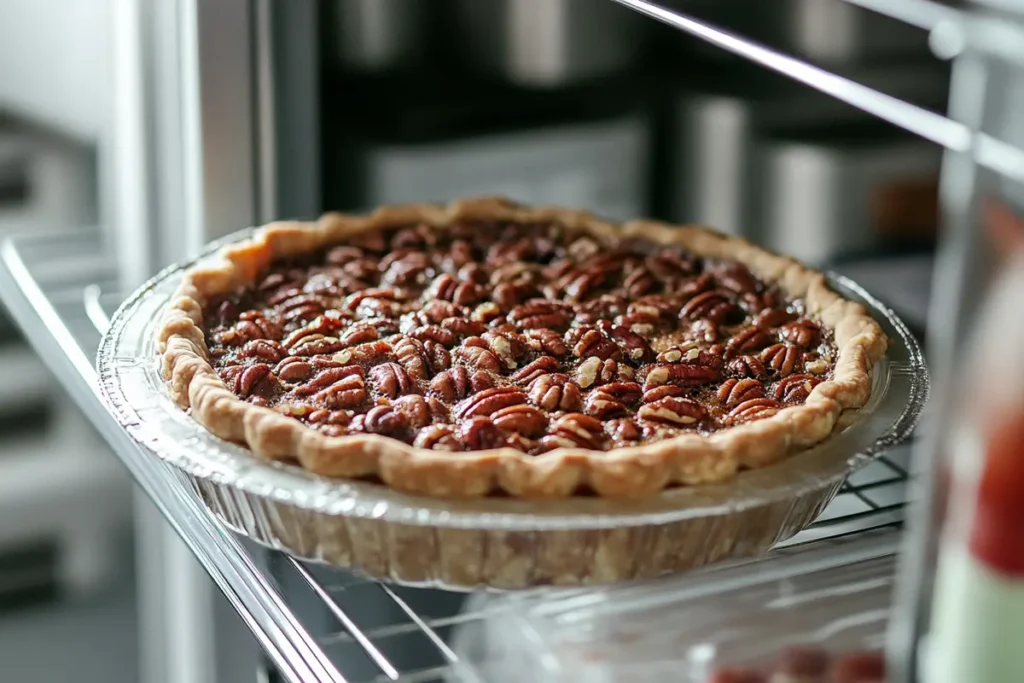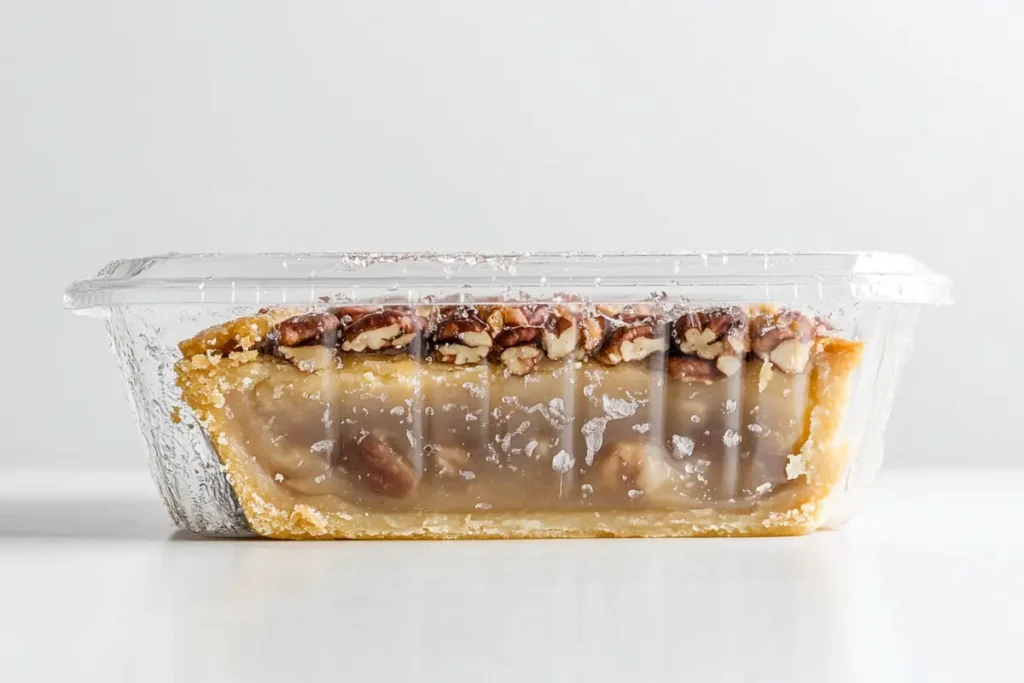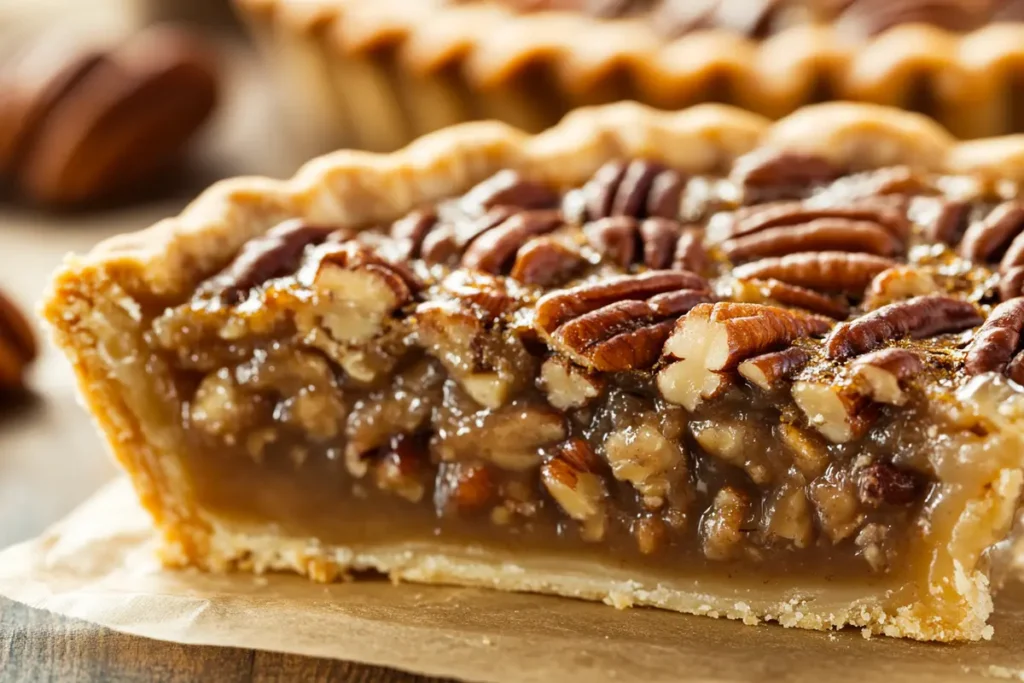Table of Contents
Introduction
Refrigerate pecan pies to maintain their deliciousness and ensure food safety. Pecan pies, with their rich, nutty filling and flaky crust, are a delightful dessert. However, proper storage is key to keeping them at their best. Many home bakers wonder about the ideal way to store leftover pecan pies. Let’s explore 5 incredible storage solutions to refrigerate pecan pies effectively, preserving their taste and texture.
Why Refrigeration is Non-Negotiable for Pecan Pies
Refrigeration for pecan pies isn’t just recommended; it’s non-negotiable for food safety. Understanding the pie’s composition and the risks of room temperature storage highlights why refrigeration is essential. Refrigeration is crucial for pecan pie safety.
Custard Filling: A Bacteria Breeding Ground
Pecan pie is a type of custard pie. Its filling contains eggs, butter, and often other dairy ingredients like cream or milk. These components create a moist, protein-rich environment where bacteria can thrive if not properly chilled. Custard filling is a bacteria risk.
Bacteria, such as Salmonella and Staphylococcus aureus, multiply rapidly in the “danger zone” temperatures between 40°F and 140°F (4°C and 60°C). Leaving custard pies at room temperature provides ideal conditions for bacterial growth. Bacteria thrive in custard filling at room temp.
Food Safety First: Preventing Foodborne Illness
The primary concern with improper storage of pecan pie is food safety. Consuming food contaminated with bacteria can lead to foodborne illnesses, causing symptoms like nausea, vomiting, and diarrhea. Food safety is paramount for pecan pies.
Refrigeration slows down or inhibits bacterial growth, significantly reducing the risk of food poisoning. Prioritizing food safety is essential, especially when serving desserts to family and friends. Refrigeration minimizes food poisoning risk.
Maintaining Quality: Preventing Spoilage and Texture Decline
Beyond safety, refrigeration is also crucial for maintaining the quality of pecan pie. Room temperature storage can lead to textural changes and flavor degradation. Refrigeration helps preserve the pie’s intended texture and taste. Refrigeration maintains pie quality and texture.
Without refrigeration, the pie’s filling can become oily or greasy as fats separate. The crust can soften and lose its flakiness. Refrigeration slows down these undesirable changes, keeping the pie more appealing for longer. Refrigeration prevents oily filling and soggy crust.

Understanding Room Temperature Limits: The Two-Hour Rule
Even when refrigeration is planned, understanding the limits of room temperature storage is important. The “two-hour rule” is a key guideline for perishable foods, including pecan pie. Two-hour rule defines room temperature limits.
Two Hours Maximum at Room Temperature
The “two-hour rule” states that perishable foods, including custard pies like pecan pie, should not be left at room temperature for more than two hours. This timeframe is crucial for minimizing bacterial growth risks. Two-hour rule is maximum room temperature time.
This rule applies after baking and cooling. Once the pie has cooled to room temperature, it should be refrigerated within two hours to ensure food safety. Two-hour limit applies after pie cools down.
Warm Environments: Reduced Timeframe
In warmer environments, particularly above 90°F (32°C), the timeframe for safe room temperature storage is even shorter. In these conditions, perishable foods should not be left out for more than one hour. Warm environments shorten safe room temp time.
High temperatures accelerate bacterial growth. During summer months or in warm kitchens, it’s even more critical to refrigerate pecan pie promptly and adhere to stricter time limits. Warmer temps accelerate bacteria growth.
Discard After Two Hours: Safety Precaution
If pecan pie has been at room temperature for longer than two hours, especially in warm conditions, it is best to discard it for food safety reasons. Do not risk consuming pie that has exceeded safe room temperature limits. Discard pie exceeding two-hour room temp limit.
While it might seem wasteful, discarding potentially unsafe food is always the safest course of action. Food poisoning is a serious risk, and erring on the side of caution is prudent. Food safety outweighs potential food waste.
Step-by-Step: Refrigerate Pecan Pie for Best Results
To refrigerate pecan pie effectively and preserve its quality, follow these step-by-step instructions. These techniques ensure both safety and optimal texture retention. Follow these steps for best refrigeration results.
Step 1: Cool Pie Completely First
Allow the pecan pie to cool completely to room temperature on a wire rack after baking. Do not rush this cooling process or refrigerate while still warm. Cool pie completely before refrigerating.
Cooling to room temperature prevents condensation from forming inside the storage container or wrapping when refrigerated. Condensation can lead to a soggy crust. Cooling prevents condensation and soggy crust.
Step 2: Cover Loosely for Initial Refrigeration
Once cooled, cover the pecan pie loosely for the first few hours of refrigeration. Use plastic wrap, foil, or an inverted container lid, but don’t seal it tightly yet. Cover loosely for initial refrigeration.
Loose covering allows for some air circulation, preventing moisture buildup while still protecting the pie from refrigerator odors and drying out excessively. Loose covering allows air circulation initially.
Step 3: Switch to Airtight Container After Initial Chill
After the pie has chilled for a few hours and is thoroughly cold, you can switch to a more airtight container or wrap it more tightly. Airtight storage prevents drying out during longer refrigeration. Switch to airtight container after initial chill.
Airtight storage is beneficial for longer-term refrigeration, preventing the pie from drying out and maintaining its moisture. Airtight storage is better for longer refrigeration.
Step 4: Refrigerate for Up to 3-4 Days
Store the pecan pie in the refrigerator for up to 3 to 4 days. Consume it within this timeframe for best quality and food safety. Beyond 4 days, discard any remaining pie. Refrigerate for maximum 3-4 days.
Label and date the pie container to keep track of the storage duration. Knowing the storage date helps ensure you consume the pie within the recommended timeframe. Label and date container for tracking.
Step 5: Reheat Gently Before Serving (Optional)
Reheating refrigerated pecan pie is optional but can enhance its flavor and texture. Reheat gently in a low oven (around 250°F-300°F or 120°C-150°C) until just slightly warmed. Reheat gently if desired in low oven.
Avoid microwaving, which can make the crust soggy. Gentle oven reheating helps restore some warmth and crispness to the crust without compromising the filling. Gentle oven reheating preserves texture best.

Tips for Maintaining Pecan Pie Crust Crispness in the Fridge
Maintaining the pecan pie crust’s crispness during refrigeration is a common concern. These tips focus on minimizing sogginess and preserving the crust’s texture. These tips preserve crust crispness in fridge.
Cool Completely Before Covering: Key to Crisp Crust
Ensuring the pecan pie is completely cooled before covering it for refrigeration is the most crucial step in preventing a soggy crust. Warm pie releases moisture that gets trapped and softens the crust. Cool completely before covering for refrigeration.
Patience is key. Allow the pie to cool to room temperature naturally before proceeding with covering and refrigeration. Complete cooling is fundamental for crisp crust.
Elevate Pie on a Wire Rack During Cooling
Cool the pecan pie on a wire rack rather than directly on a countertop or plate. Elevating it allows air to circulate around the pie, promoting even cooling and preventing moisture from accumulating underneath. Cool pie on wire rack for air circulation.
Air circulation is essential for preventing condensation and ensuring the crust remains crisp as it cools. Wire rack promotes even cooling and crispness. Wire rack promotes air circulation and crispness.
Loose Covering Initially: Allow Crust to Breathe
Using a loose covering, rather than airtight wrapping, for the first few hours of refrigeration allows the crust to “breathe” and prevents moisture from being trapped directly against it. Loose covering allows crust to “breathe”.
This initial loose covering helps maintain the crust’s texture during the critical early chilling phase. After the pie is thoroughly cold, you can switch to tighter wrapping. Loose covering is crucial for initial chill.
Reheat Gently in Oven: Revive Crispness
If the crust does soften slightly during refrigeration, gentle reheating in a low oven can help revive some of its crispness. Reheat briefly just until warmed through, avoiding prolonged heating. Gentle oven reheating can revive crispness.
The low oven heat can help evaporate any excess moisture in the crust and restore some of its original crisp texture. Gentle reheating is key to avoid toughening the crust. Gentle reheating revives slight crust softening.
Common Mistakes to Avoid: Pecan Pie Storage Faux Pas
Several common mistakes can undermine your efforts to store pecan pie safely and maintain its quality. Avoiding these faux pas will improve your storage outcomes. Avoid these common storage mistakes.
Refrigerating Pie While Still Warm
Refrigerating pecan pie while it’s still warm is a major mistake that leads to condensation and a soggy crust. Always ensure the pie is completely cooled to room temperature before refrigeration. Avoid refrigerating warm pie directly.
Patience is essential. Rushing the cooling process only compromises the pie’s texture and enjoyment. Cooling completely is crucial for crust texture.
Using Airtight Containers Too Soon
Using airtight containers or wrapping the pie too tightly immediately after cooling can trap moisture and soften the crust. Allow for loose covering initially for air circulation. Avoid airtight containers immediately after cooling.
Airtight storage is beneficial for long-term refrigeration after the initial chill, but not during the cooling and early refrigeration phase. Loose covering initially is key.
Leaving Pie at Room Temperature for Extended Periods
Leaving pecan pie at room temperature for longer than two hours is a significant food safety mistake. It increases the risk of bacterial growth and potential foodborne illness. Do not leave pie at room temp too long.
Prioritize food safety over convenience. Adhering to the two-hour rule is crucial for preventing health risks. Food safety should always be prioritized.
Freezing Without Proper Wrapping
If freezing pecan pie for longer storage, failing to wrap it properly can lead to freezer burn and degradation of quality. Wrap tightly in plastic wrap and then foil for freezer storage. Wrap frozen pie properly to prevent freezer burn.
Proper wrapping prevents moisture loss and protects the pie from freezer odors and texture changes during long-term frozen storage. Proper wrapping is essential for freezer storage.

Refrigerate Pecan Pie: Your Delicious Dessert, Safely Stored
Refrigerate pecan pie – it’s the essential step for safe and enjoyable storage. By following these delicious and incredible storage secrets, you can ensure your pecan pie remains both safe to eat and retains its delightful taste and texture for days. Proper refrigeration allows you to savor every slice with confidence and pleasure. Refrigerate pecan pie for safe and delicious enjoyment.
FAQ
How do you store pecan pie after baking?
To store pecan pie after baking, allow it to cool completely to room temperature. Then, cover it loosely with plastic wrap, foil, or an inverted container lid and refrigerate promptly within two hours. For longer storage, after initial refrigeration, you can wrap it more tightly or place it in an airtight container.
What happens if you don’t refrigerate pecan pie?
If you don’t refrigerate pecan pie, especially for extended periods, it can become unsafe to eat due to potential bacterial growth in its custard filling. Leaving it at room temperature for more than two hours, particularly in warm conditions, increases the risk of foodborne illness. Additionally, the pie’s texture and quality can decline at room temperature.
How long does pecan pie last in the refrigerator?
Pecan pie will last for 3 to 4 days in the refrigerator when stored properly. It is recommended to consume it within this timeframe for the best quality and to ensure food safety. Beyond 4 days, discard any remaining pie.
Can pecan pie be left out overnight?
No, pecan pie should not be left out overnight at room temperature. Due to its custard filling containing eggs and dairy, it is considered a perishable food. Leaving it at room temperature overnight or for more than two hours poses a food safety risk. Refrigerate pecan pie promptly after it cools to room temperature.

